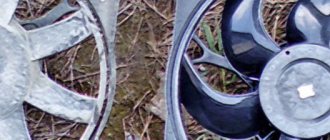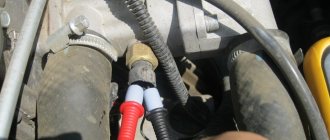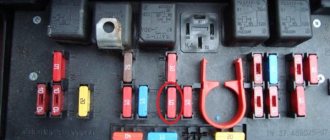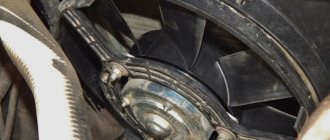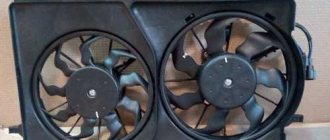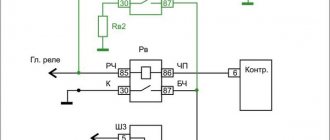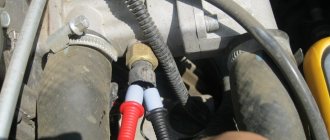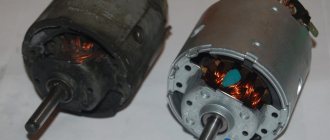The situation when The cooling fan is constantly running can be caused by several reasons: failure of the coolant temperature sensor or its wiring, failure of the fan start relay, damage to the drive motor wires, glitches of the electronic engine control unit (ECU) and some others.
To understand how the cooling fan should work correctly, you need to know what temperature is programmed in the control unit to turn it on. Or look at the data on the fan sensor located in the radiator. Usually it is within +87…+95 °C.
In the article we will look in detail at all the main reasons why the engine radiator cooling fan works not only when the coolant temperature reaches 100 degrees, but always when the ignition is turned off.
| Reasons for turning on the fan | Conditions for inclusion |
| Failure of the DTOZ or damage to its wiring | Engine running in emergency mode |
| Shorting the wires to ground | The engine is running, when the contact appears/disappears, the fan may turn off |
| Short circuit of wires to ground with two DTOZH | Engine running (first sensor) or ignition on (second sensor) |
| Faulty fan relay | Engine running in emergency mode |
| ECU “glitches” | Different modes, depending on the specific ECU |
| Radiator heat transfer is impaired (contamination) | With the engine running, during a long trip |
| Faulty freon pressure sensor | With the air conditioner on |
| Low cooling system efficiency | When the engine is running |
Operating principle of radiator fan
Before considering this issue, let us discuss in general what the water cooling system of an internal combustion engine is, shown in the figure below. It will allow us to remember the principle of its operation.
In cases where cold liquid passes through the motor jacket, it picks up excess heat, while the engine cools and the water heats up. Then it passes through the radiator, where it releases the resulting heat into the atmosphere, and again enters the engine.
The radiator design is a set of thin tubes that create a large cooling surface. The incoming air flow, passing through it, carries away excess heat that is stored in the liquid. In cases where there is no incoming air flow (engine idling, traffic jams and other similar situations), or it is not enough to cool the water to the desired temperature, the cooling radiator fan is provided for.
For this purpose, there is a special control circuit, the basis of which is the thermal switch of the radiator fan. It controls the temperature of the liquid. When it exceeds the established limits, the sensor is triggered and, based on its signal, the radiator fan is turned on, which creates the necessary air flow. This flow cools the heated water, and when its temperature reaches the required value, the sensor is triggered again and turns off the blowing.
This is how you can describe the basic principle by which the radiator fan works - it turns on when the water temperature exceeds the set temperature, and turns off after it drops to the desired value.
I turn on the ignition and the cooling fan comes on.
Hi all. question for the experts. situation: after assembling (I didn’t assemble it myself) a 1.5L engine (07 my), when the ignition is turned on, the fan on the radiator of the cooling system starts working. where to look for the reason for the operation? what can you recommend?
I know one with similar symptoms (if you turn on the fans) it means the brain is working in emergency or service mode! When you start it does the check light come on? Is the speed sensor connected to the boxes?
When YOU are on SUBARU, YOU are obliged to help the one who is on SUBARU (if he needs it.)
I know one with similar symptoms (if you turn on the fans) it means the brain is working in emergency or service mode! When you start it does the check light come on? Is the speed sensor connected to the boxes?
I'll get some advice and go check everything tomorrow. )
It looks like either the coolant temperature sensor has failed, or they simply forgot to put the connector on it.
or not all the chips were connected to the brains
I'll get some advice and go check everything tomorrow. )
What are the consequences if the radiator fan does not work?
An internal combustion engine is a complex device, and its performance is optimal when it operates at a certain temperature. As noted above, it depends on the correct operation of the cooling system. In the case when it is not possible to maintain the required temperature, the consequences will be quite sad - if the engine overheats, it may well jam and then, at a minimum, a major overhaul is guaranteed.
The stability of the entire system should be created by a fan, allowing the water temperature to be reduced in any conditions. But if it doesn’t work, especially when it’s hot, then you need to look for why the fan doesn’t turn on or doesn’t spin. Nowadays, such devices are usually electrical, and failure of the product itself is unlikely, and a possible reason for this is often the failure of its wiring (sensor, fuse, connecting wires, etc.).
This means that when figuring out the reasons why the radiator cooling fan is constantly running or why it doesn’t turn on or spin, you must first check the wiring of the device.
What's the result?
Having examined the operating features of the radiator fan, it becomes obvious that the internal combustion engine cooling system as a whole and the engine cooling fan itself make it possible to maintain the required temperature regime of the internal combustion engine.
It is also important to understand that the uninterrupted operation of the cooling system depends on the coordinated operation of all components. For example, the fan normally turns on when the engine temperature rises above 90°C to cool the engine, and then should turn off.
However, in practice, you can often independently diagnose a problematic device, identify the cause of the breakdown and, if possible, fix the problem. Finally, we note that most problems associated with engine overheating can be avoided through preventative checks, as well as regular cleaning of the cooling fan terminals and contacts.
There is air in the engine cooling system: symptoms of airing, reasons for the formation of an air lock. How to bleed the engine cooling system.
The engine cooling fan turns on when the engine is cold or after the ignition is turned on: the main causes and solutions to the problem.
Design and principle of operation of a radiator cooling fan. Common faults, troubleshooting and repairs. Tips for use.
Common engine cooling system failures: water pump, thermostat, radiator, cooling fan and others. How to determine the reasons yourself.
Why does the engine overheat or boil while the cooling radiator is cold? Signs of engine overheating, how to prevent serious consequences.
Radiator in the cooling system, design and principle of operation, thermoregulation of the coolant. Troubleshooting and self-repair
Source
How to check a radiator fan
As we have already established, the radiator fan should turn on when the temperature of the water (antifreeze) exceeds the set value. This can be checked by the instrument readings on the front panel. If the fan does not turn on, then it is necessary to check the entire signal chain.
- Check the presence of supply voltage coming to the product. To do this, you can use a tester or a light bulb. The absence of voltage will indicate a possible blown fuse or poor contact in the wires.
- The serviceability of the fan itself can be checked by applying voltage to it directly from the battery. If it spins, then everything is fine with it, and the defect must be looked for in other devices. If not, and the fan does not spin, then this is the cause of the defect. In principle, you don’t have to stand still and move on, but you must constantly monitor the engine temperature. When the arrow approaches the red sector, you need to stop, open the hood and cool the engine. Two techniques will allow you to move in this case too. Maintain a speed of at least sixty km/h, then the constantly flowing oncoming air will cool the water passing through the radiator, and you will be able to drive as usual as long as you maintain speed. Another technique that allows you to partially replace a non-working fan is to use heating. Turn the stove to maximum heating mode, in this case some of the excess heat will escape through the heater. True, the cabin will be like a bathhouse, but you will be able to get to the nearest service station.
- To check the sensor, you need to disconnect the wires from it and short them together. If the fan turns on and spins, it means that the sensor itself is not working; it cannot be repaired, only replaced. However, if you leave the wires closed, you can move on; with this option, the fan spins constantly, although it is possible that the engine temperature will be lowered, but this is better than standing still.
Radiator fan runs constantly
This case is partially discussed above; the cause is a failure of the temperature sensor or a short circuit in the wires going to the fan. But if it is constantly spinning, then this may be caused by a stuck relay. This happens quite often, especially after the relay is triggered and the fan should turn on. Sticking relay contacts mean that they cannot open, which causes a constant voltage supply to the contacts, causing the electric motor to spin constantly. The consequences of sticking relay contacts include the fact that the radiator fan does not turn off.
Often the thermostat may be the reason why the fan shutoff does not work . The fact is that the sensor is located in the head of the unit; it determines when the fan should turn on. But the coolant can move in a large and small circle; when it moves in a small circle, it does not enter the radiator for cooling. The mode of water movement is determined by the thermostat.
If it is jammed in the position of water moving in a small circle, then it will continue to move and overheat, which will trigger the sensor and turn on the fan, but because... water does not enter the radiator, it will not cool, and the sensor will constantly signal a high temperature. As a result, the radiator fan does not turn off. This case can be determined simply - you need to touch the hoses going to the radiator. When the thermostat is stuck, they will be cold if the engine is overheated.
If the radiator fan does not turn off due to a jammed thermostat, then sometimes you can knock on the case to eliminate this phenomenon. Often this is enough and the defect disappears. If everything remains unchanged, then you will have to remove the thermostat, take out all the stuffing from it and then put the device itself back in place. Another option for the same defect would be the thermostat getting stuck in an intermediate position. This can also result in the radiator fan not turning off, but this situation is much more difficult to diagnose. Such difficulties are caused by the fact that a certain amount of water enters the radiator, but too little of it passes through, all the water does not have time to cool, which leads to overheating of the engine.
All of the above is not a complete description of the possible reasons why the radiator fan does not turn off. There can be many of them, sometimes quite strange and unexpected, but in each of these manifestations of malfunctions it is necessary to look for the reasons and conduct a thorough analysis.
Diagnostics
Before trying to determine why cooling system fans may turn on when the engine is cold in cars, it is recommended that you understand the operation of this unit.
The fan is turned on due to the operation of a special sensor, which activates the rotation of the blades. This controller is located at the bottom of the cooling radiator.
There are some modern cars where the engine control unit is responsible for starting, although this is rather a rarity and the exception and the rule.
When the cooling liquid (coolant) reaches the required temperature, which is usually in the range of 100-105 degrees Celsius, the sensor closes the electrical circuit, and this allows the fan to turn on. It starts blowing on the radiator. This achieves a better cooling effect, since the air and liquid systems are combined.
At the same time, there are situations when the engine is still absolutely cold, it does not require any additional cooling, but the fan still turns on. This is not a normal condition. It is necessary to look for the reason for this behavior of the cooling system and eliminate any malfunctions that have arisen.
If you continue to ignore the constantly running fan, the initially simple discomfort will give way to more serious problems.
But here it is important to note that the constant operation of the blades is not as dangerous as a complete failure of the device. Although this fact is absolutely not a reason to do nothing
It all starts with diagnosis. The simplest and most convenient in this regard are injection engines. To detect a malfunction, it is enough to conduct computer diagnostics. This is done both in a car service center and in the garage with your own hands.
Connecting to an electronic control unit makes it possible to obtain error codes that are not difficult to decipher and understand the true reasons for this behavior of the cooling system fan.
There are situations when the ECU detects a malfunction in the cooling system and causes the fan to spin constantly, even when the engine is cold. This is a kind of protective function aimed at preventing possible overheating of the internal combustion engine. Therefore, when errors are detected and after troubleshooting, a reset is required. To erase errors, you should look at the owner's manual for your car. On some cars, it is enough to remove the terminal from the battery, and the errors will be erased. On other cars, errors are erased using connected diagnostic equipment.
If the option of computer diagnostics does not suit you or it cannot be used for one reason or another, you will have to use the method of elimination to check all potential sources of trouble.
Radiator fan turns on early
The other extreme is the situation when the fan turns on early. In this case, you need to look again at the temperature sensor. Most likely it needs replacing. If, of course, you have the right sensor. The fact is that sensors are designed for different temperatures; they are also called summer and winter; each of them must turn on in its own temperature range. The latter work later. And if you have been using these all the time, then it may seem to you that the fan turns on early, although it is done on time and everything works correctly.
We need to really evaluate how early everything happens. If early switching is set according to the readings on the instrument cluster, then this is not an indicator. However, when such inclusion causes concern, connect the appropriate equipment via the diagnostic channel and look at the actual thresholds of the sensor.
Cooling the car engine is the most important task. If you allow the engine to overheat, then at best it will need a major overhaul. The ability to operate a vehicle in any conditions is ensured by the reliable operation of the cooling system, which is largely determined by the correct operation of all its components. » alt=»»>
The AliExpress portal, in partnership with AvtoFun, has prepared for our readers discounts of up to 60% on all automotive products:
A fan that comes on when the engine is cold and runs constantly while driving is a fairly common problem, despite its appearance. Its reasons are usually prosaic, but sometimes they involve significant costs. This error happened to our friend in a Chevrolet Aveo T300 equipped with the same 1.2 ECOTEC 86 HP engine as the Opel Corsa D or A12XER. We took the car to our workshop to find the source of the problem. See what caused this confusion and what the cost of this mistake is.
The radiator fan is one of the key elements of the engine cooling system. It causes intense airflow through the radiator core, drawing in air (the fan is located at the rear of the radiator on the engine side). Its operation is especially important when driving around the city, which is accompanied by frequent stops of the car, which makes it impossible to cool the coolant with the air blowing through the car. Fan designs have changed over the years, but the most common fans today are motor-driven. This type of design is usually controlled by a thermal relay screwed into the outlet (cooler) of the radiator tank. And it is this element that most often causes problems in fan operation. Sometimes, however, the cause of poor fan performance lies elsewhere.
Cooling fan
Before we talk about troubleshooting, we should say a few words about the cooling fan itself. It serves to create a flow of air directed towards the radiator and serves to cool the latter. The fan turns on automatically when the temperature sensor located under the radiator is triggered.
When the coolant reaches a temperature of 100-105 C, the sensor closes and starts the rotation of the fan, which blows over the radiator and cools it. As you can see from this, normal fan activation is only possible when the engine is fully warmed up, and starting it when the engine is cold indicates obvious problems in the system.
Operation of the VAZ 2114 cooling system
Engine fan runs constantly while driving
In the presented generation Chevrolet Aveo II, a problem with the fan appeared one morning. When the engine started, the fan immediately turned on, even if the engine was completely cold. The owner was further alarmed that the fan was running all the time while driving and a yellow engine light appeared on the clock. "Check the engine." He decided to return the car to our mechanic Pavel, who immediately began a basic check of the car's technical condition.
Location of the coolant temperature sensor and its replacement
Replacing the fluid temperature sensor is not a difficult task (although a lot depends on how the engine is installed in the chamber). Most often it is located in the engine head and should be looked for in its vicinity. When checking its condition, it is necessary to take into account the fact that the car may have a second, so-called Liquid Temperature Sensor located on the radiator itself.
Location of the coolant temperature sensor and its replacement
This was the case with the presented Aveo T300. However, the faulty sensor was located in the engine head and was very easy to access . This can be achieved manually without removing the motor housing. Although the Aveo T300 is more than the latest Opel Corsa design, it is still a car with good access to engine hardware. The second of the sensors, the so-called Controlled one, fortunately, was in good shape, but even the Aveo T300 has pretty good access to it.
When replacing the coolant temperature sensor, the coolant must be drained from the system, since the sensor is partially immersed in it. After replacing the sensor, fill the system with new coolant, drain it and warm up the engine.
Confinement of mass
The functioning of the fan depends on different methods, as you have already seen from reading this article. There is another reason that disables the fan's performance. For example, if the corresponding wires are poorly screwed to the body, the fan is connected directly to the battery. It should be noted that in this case, it is necessary to take timely measures to avoid serious problems.
With this option, you can expect the car to catch fire. If a strong short circuit occurs, then all the wires will heat up accordingly. To avoid serious consequences, you should check the connections and wires that have access to the sensor. Reliable fastening of wires and intact insulation reduces the risk of serious consequences.
Cost of replacing the coolant temperature sensor
The coolant temperature sensor is a relatively cheap component, although much depends on the popularity of the car model. In the case of the Chevrolet Aveo T300, the original part costs about 1,200 rubles. A replacement RIDEX can be purchased for about 400 rubles, and for ABS - 700 rubles.
To replace the sensor, an authorized service center charges a fee of approximately PLN 160. In an unauthorized workshop, the cost of the same service will be about 1,700 rubles. The difference is therefore clear, especially when you consider the relatively small amount of work required to complete the job.
The engine fan turns on frequently - reasons
In the case of the Chevrolet Aveo 1.2 ECOTEC 86 HP, presented for the incorrect operation of its fan, corresponded to a simple and easy fix. Therefore, the owner of the vehicle can talk about great luck. It happens that a faulty fan module . And this, unfortunately, comes with a definitely higher cost of repair! The module is an integral part of the fan, and if it fails, the entire fan is replaced! In the case of the presented Aveo, this means costs of 30,000 rubles for the original part! And although this seems like a huge amount, compared to a fan for a BMW 520d E60, it costs up to 48,000 rubles at the dealership!
The engine fan turns on frequently - reasons
However, if we look for substitutes, we can clearly reduce this cost. POLCAR's offer includes a good replacement for the Aveo fan for 6,000 rubles (with housing). This means almost 5 times the difference in cost! It is not surprising that buyers very rarely decide to purchase an original part for this type of repair.
Many people wonder why the cooling fan constantly works or turns on frequently. After all, this is evidence of poor performance of the cooling system. This can lead to overheating of the motor and its failure. This problem is quite serious, in some cases, to eliminate it you will even have to partially disassemble the engine. The smooth operation of the power unit depends on how quickly you identify the malfunction. Inspection and repair do not require special skills; anyone can do it. The main thing is to know how to search for the reason for this behavior of the cooling system.
Why the cooling fan constantly works or turns on frequently becomes clear from the principle of its operation. It is activated by a sensor located at the bottom of the cooling radiator. This sensor reacts to an increase in coolant temperature, as a result, the fan turns on. It creates an additional air flow, which enhances the cooling of the liquid in the radiator and, accordingly, the engine itself. Based on this, it becomes clear that the fan is constantly running, only on overheating power units. To avoid engine failure, it is necessary to respond to the problem in a timely manner and fix it.
DD or pressure sensor
You should be aware that on some cars where the air conditioning is turned on, 2 sensors are used in the fan activation circuit. One of them is the DVV, but it is more correct to call it a temperature sensor, because it turns on the fan based on the temperature readings.
The second sensor is a pressure regulator or pressure regulator. If the DVV is in front of the thermostat, then the DD is in the air conditioning system on the high pressure line. It operates and is activated exclusively by pressure up to 15 bar. Accordingly, if the pressure rises above this value, an additional car fan turns on.
Why does the fan turn on when the ignition is turned on?
Thus, if the air conditioner or fan turns on when you turn on the ignition, this may indicate a failure of the pressure sensor.
It is also likely that the chip was disconnected. This often happens by accident, due to the fact that in some cases the DD is placed near the battery, next to the filling channels.
water pump
In many cases, the reason for the increase in coolant temperature in the radiator is poor operation of the water pump. In this case, the antifreeze moves slowly through the system and heats up too much. Once it gets into the radiator, it does not have time to cool down to normal temperature, and goes around the next circle, heating up even more. If the pump at least works, then this problem is expressed only by the constant operation of the fan. If the pump fails completely, then the car will “boil” in a matter of minutes. This is an extremely dangerous condition that almost always leaves consequences in the form of engine problems.
Usually the water pump does not suddenly fail. First, it gives signals about its malfunction. The first warning sign is an increase in the frequency of operation of the radiator fan. The main cause of failure is destruction and jamming of the bearing. Therefore, a manifestation of a breakdown may be a howling noise from under the hood or a knocking sound that is clearly audible when idling. Often a knocking sound from the pump is mistaken for a camshaft fault. The breakdown is eliminated by replacing the pump; in some models it is possible to replace only the front part of the pump along with the bearing.
Thermostat
Engine overheating often occurs due to jamming of this element. The fan reacts to this, in the case of the thermostat being stuck half open. At the same time, the movement of liquid through the system slows down, which causes a decrease in the efficiency of heat removal. As a result, the engine begins to overheat, and the coolant temperature rises accordingly. The fan switch sensor reacts to this. As a result, it works constantly.
Checking the thermostat is quite simple. To do this, start the engine and warm it up to the temperature at which the thermostat valve operates. This indicator is indicated on the body of the thermostat itself. We wait a little more and check the temperature of the upper and lower pipes. If both pipes are evenly hot, then the reason for the constantly running fan has been found. To be more sure, carefully inspect the thermostat valve after removing the part from the engine. Fix the problem by replacing the thermostat with a working spare part.
Article on the topic “How to check the thermostat.”
Cooling system channels clogged
Quite often, overheating is caused by congestion in the cooling system. This problem is often quite difficult to identify. Therefore, at the first sign of the fan turning on more frequently for no particular reason, you should first flush the system. In many cases this is enough. Also, just in case, you can bleed out the radiator.
Typically, cleaning the radiator and cooling channels is carried out together with replacing the antifreeze. To flush, drain the coolant. Then pour in a strong solution of citric acid or water with special additives. Then let the car run for half an hour. The used cleaning agent is drained and fresh antifreeze is added. In most cases, such a procedure helps to ensure that contaminants in the cooling system are eliminated.
What should I add? Antifreeze (and what color) or antifreeze?
First, let's resolve the issue of confusion in terms. Antifreeze is not a type of technical fluid. This is the brand under which antifreeze is produced. That is, once again, antifreeze is antifreeze.
Another question is about antifreeze colors. The answer here is simple: the color of antifreeze is determined by the dye
.
And the working qualities do not depend on the color, but on the so-called tolerance
. Antifreeze approval is some mysterious numbers with letters, like “G12++”. The car manufacturer must write in the documentation for the car what tolerance the antifreeze poured into the cooling system must have. So if you have red antifreeze with G12++ approval, you can safely add green antifreeze with the same approval to the system - everything will work normally. The resulting brown color will only be a little disappointing - but this only affects aesthetics.
Radiator contamination
All car enthusiasts know that the radiator is located in front and is blown by the headwind. Therefore, it is he who gets all the dust and dirt that comes across on the road. Gradually, this dust collects between the radiator plates, significantly impairing heat transfer. Air flows, in this case, cool the liquid much worse. It gradually heats up to a high level and causes the fan to turn on.
The repair in this case is simple; you need to clean the radiator. On many modern cars you will have to remove it first, in some cases it is quite possible to get to it without even removing it from the car. It is recommended to rinse it with running water. The easiest way to do this is to use a hose. In some cases, it makes sense to clean the radiator with a soft, dry brush before washing. Often this procedure is combined with radiator purging.
Operating principle and design features
Each type of fan has its own design nuances and operating principle. Let's look at each type in more detail:
1. Fan with viscous coupling. Such products are often found in models with a longitudinal installation of the power unit. At the same time, the systems are mounted, as a rule, on SUVs, and with the advent of electronics they began to gradually go out of use.
On the other hand, electronic devices are afraid of moisture, and the viscous coupling has maximum tightness and continues to work even after “bathing”.
2. Fan with ECU. Such systems consist of several structural elements - a temperature sensor, a power unit ECU and a fan relay. On modern cars, as many as two monitoring sensors are most often installed.
One is mounted directly in the pipe coming out of the radiator, and the second is installed at the outlet of the power unit. In this case, the thermostat is activated based on the difference in the readings of these devices.
In addition, on new VAZ models, other devices can take part in the fan control system, such as a crankshaft speed sensor and a flow meter.
In this case, all pulses are sent to the ECU, which, after analysis, gives a command to operate the device.
3. Fan with thermal switch. Old VAZ models did not have an electronic control unit, so the task of activating the device was assigned to a special thermal switch.
Air jams
It is no secret that the cause of excessive heating of the liquid is air locks. They appear due to errors when replacing antifreeze, as well as due to leaks in the cooling system. As a result, the liquid heats up unevenly, which leads to unstable operation of the fan, with frequent starts when hotter liquid enters the radiator.
Before troubleshooting, be sure to check the system for fluid leaks. Having eliminated them, they move on to clearing out the traffic jams. For this you will need a compressor. Unscrew one of the tubes supplying coolant to it from the throttle. Next, you need to connect a compressor to the neck of the expansion tank and supply compressed air to it. Usually a couple of minutes is enough to clear all existing traffic jams.
Sensor short circuit
. Quite often the sensor shorts out. In this case, the fan either threshes without stopping, or turns on much earlier than scheduled. If you have such suspicions, you need to pay attention to the time the fan turns on and compare the turn-on temperature with the standard one. If the temperature is lower, then you just need to change the sensor and everything will return to normal.
Insulation for the winter
. Many car enthusiasts install special insulation on the radiator in winter, this allows them to reduce the time it takes to warm up the car and save fuel. But during thaws the air temperature is quite high. If there is insulation, the motor does not cool enough, which forces the fan to work more intensely. To eliminate the cause, simply remove the insulation from the radiator.
Conclusion
. The cooling system of the machine must always be in good condition. Therefore, the driver needs to carefully monitor the condition of this system. It is especially important to correctly find the reason why the cooling fan constantly works or turns on frequently. This is certainly not a fatal problem, but ignoring this signal can lead to serious engine problems.
Verdict
If there is enough antifreeze in the system, the reasons for the operation of the radiator cooling fan on a cold engine are exclusively electrical in nature. On the carburetor, this is a coolant temperature sensor built into the heat exchanger, or a closed ground.
On the injector, the most likely causes are a stuck relay, a shorted negative switch, and a DTOZH. On turbo versions, this is the control unit or the impeller itself. Emergency operating condition and bugs in the firmware are more serious reasons for the abnormal behavior of the wind blower.
